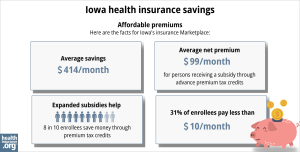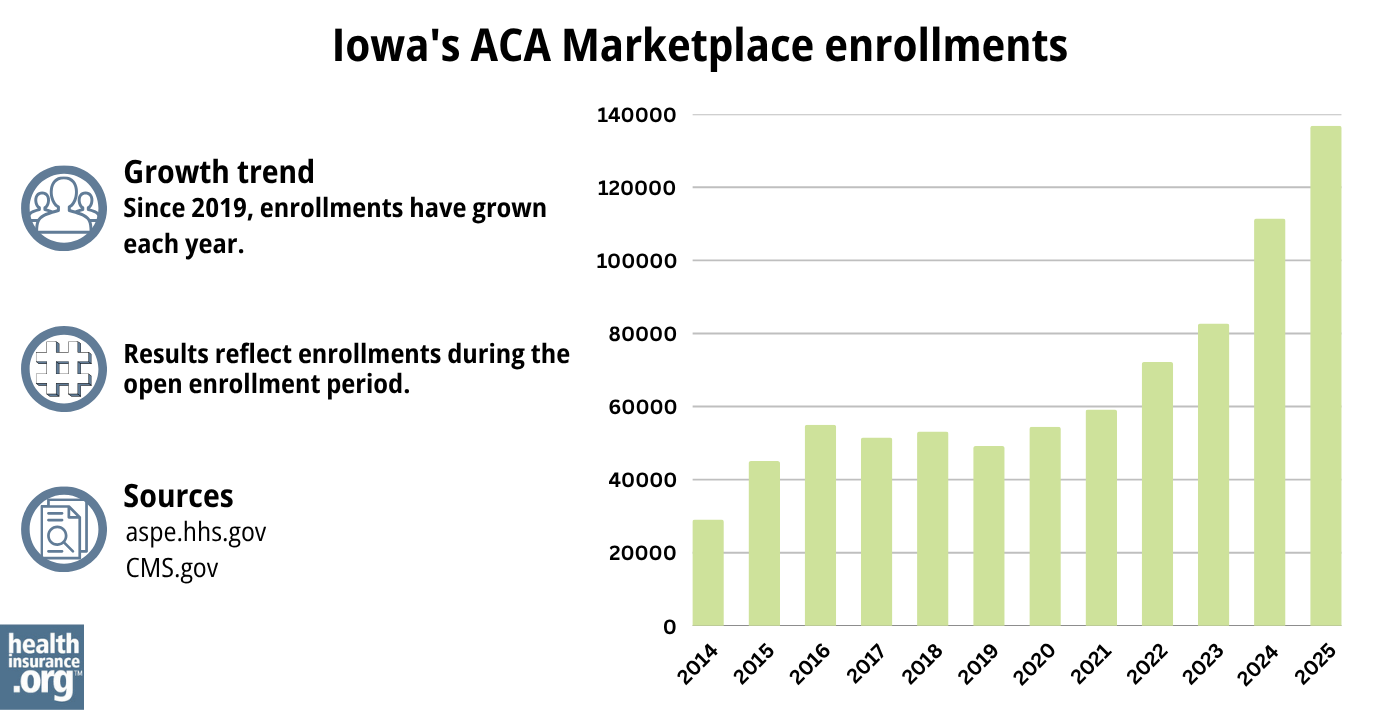Home > Health insurance Marketplace > Iowa
Iowa Marketplace health insurance in 2025

Compare ACA plans and check subsidy savings from a third-party insurance agency.

Iowa health insurance Marketplace guide
If you’re looking for an affordable health insurance plan in Iowa, this state guide, including the FAQs below, can help you better understand your coverage options. For many, an Affordable Care Act (ACA) Marketplace plan, also called Obamacare or an exchange plan, is a cost-effective option.
Iowa runs a partnership exchange with the federal government. Residents use HealthCare.gov to compare plans and enroll in coverage.
Five private insurance companies offer health plans through Iowa’s exchange/Marketplace for 2025, including two new carriers: UnitedHealthcare3 and Iowa Total Care (Ambetter).4 Two of the three existing insurers are reducing their average full-price premiums for 2025.5 (see details below).
Iowa still has a fairly large number of residents enrolled in pre-ACA individual health insurance plans (grandmothered or grandfathered plans). As of 2024, about 25,000 people were enrolled in Wellmark’s pre-ACA individual market plans in Iowa, and numerous public comments were submitted regarding the proposed 2025 premium increases for those plans.6
None of these enrollees are receiving premium subsidies, since subsidies are not available for pre-ACA plans. As described below, average premiums for Iowa Marketplace plans are decreasing or only slightly increasing for 2025,5 and 90% of Iowa Marketplace enrollees qualify for financial assistance with their premiums. 7 It’s important for people with pre-ACA plans to understand Marketplace options and subsidy eligibility before renewing their pre-ACA coverage.
Frequently asked questions about health insurance in Iowa
Who can buy Marketplace health insurance?
Anyone who meets the following criteria can buy Marketplace health coverage in Iowa:
- You must live in Iowa
- You must be a U.S. citizen, national, or lawfully present
- You must not be incarcerated
- You must not be enrolled in Medicare
Eligibility for financial assistance (premium subsidies and cost-sharing reductions) is based on your income. Moreover, to qualify for financial assistance with your Marketplace plan, you must:
- Not have access to affordable health coverage through an employer. If your employer offers coverage, but you feel it’s too expensive, use our Employer Health Plan Affordability Calculator to see if you might qualify for premium subsidies in the Marketplace.
- Not qualify for Medicaid or CHIP.
- Not be eligible for premium-free Medicare Part A.8
- If married, file a joint tax return.9
- Not be able to be claimed by someone else as a tax dependent.9
When can I enroll in an ACA-compliant plan in Iowa?
You can sign up for an ACA-compliant individual or family health insurance in Iowa between November 1 and January 15 during open enrollment.10
Here are some key dates to remember:
- If you enroll by December 15, your coverage starts on January 1.
- If you enroll between December 16 and January 15, your coverage begins on February 1.
If you miss open enrollment, you may still get coverage through the Marketplace if you have a qualifying life event. Examples of qualifying life events include loss of health coverage, gaining a dependent, or permanent relocation (assuming you already had coverage prior to the move).
Some people can enroll in ACA Marketplace plans year-round without a specific qualifying event, including:
People who lose Medicaid/CHIP between March 31, 2023 and November 30, 2024 can enroll in a Marketplace plan at any point during that time, and are not limited to the normal 60-day deadline to sign up for new coverage.13
How do I enroll in a Marketplace plan in Iowa?
You can enroll in an Iowa health insurance Marketplace plan by:
- Visiting HealthCare.gov
- Calling 1-800-318-2596 (TTY: 1-855-889-4325). The call center is available 24 hours a day, seven days a week, but it’s closed on holidays.
You can also find local help from local insurance agents, brokers, certified application counselors or an approved enhanced direct enrollment entity.14 They can review options and help you pick a plan to fit your needs. Find local help at localhelp.HealthCare.gov
How can I find affordable health insurance in Iowa?
You can find affordable health plans in Iowa on the ACA Marketplace (HealthCare.gov).
As of early 2024:
- Nine out of ten Iowa Marketplace enrollees qualified for premium subsidies.15
- These premium subsidies (called Advance Premium Tax Credits or APTC) saved Iowa Marketplace enrollees about $508/month on average in 2024.15
- Across all Iowa Marketplace enrollees, including the 10% who paid full price, average net premiums amounted to about $127/month.15
(Note that the chart below shows data for everyone who signed up during the open enrollment period for 2024 coverage, while the data above is for effectuated enrollments as of early 2024.)

Source: CMS.gov16
In addition to APTC, if your household income isn’t more than 250% of the federal poverty level, you may also be eligible for cost-sharing reductions (CSR). CSRs help reduce deductibles and out-of-pocket expenses. Note that you must select a Silver-level plan to take advantage of CSR benefits.
Depending on your household income, you may qualify for Iowa Medicaid instead of Marketplace subsidies. Short-term plans can be a low-cost option for people not eligible for Medicaid, Medicare, or Marketplace subsidies (as of September 2024, new short-term policies are limited to initial terms of no more than three months, and total duration, including renewals, of not more than four months).
As of 2023, there were still nearly 30,000 people in Iowa who were enrolled in individual grandfathered or grandmothered health plans.17 These plans do not have to comply with various aspects of the ACA, and people enrolled in these plans cannot get the financial assistance that’s available via the Iowa Health Insurance Marketplace. If you’re enrolled in a pre-2014 health plan, it’s important to double-check your options in the Iowa Marketplace during open enrollment, to see if a newer plan might provide better coverage and/or lower premiums.
How many insurers offer Marketplace coverage in Iowa?
In Iowa, five companies sell plans through the exchange for 2025, including two new carriers. The Iowa Insurance Division has confirmed that two carriers — Medica and Wellmark Health Plan of Iowa — will offer plans statewide in 2025. The other three carriers will offer plans in some counties but not others: Iowa Total Care will offer plans in 33 counties. Oscar will offer plans in 75 counties, and UnitedHealthcare Plan of the River Valley will offer plans in 17 counties.18
UnitedHealthcare and Iowa Total Care (Ambetter) are new for 2025,34 bringing the number of participating insurers to five in Iowa’s Marketplace.18
And two of the three current insurers are reducing their average premiums for 2025 (before subsidies are applied).5
Are Marketplace health insurance premiums increasing in Iowa?
The following average rate changes were approved for 2025 for Iowa’s individual market insurers.5 (Average rate changes are calculated before subsidies are applied.)
Iowa’s ACA Marketplace Plan 2025 APPROVED Rate Increases by Insurance Company |
|
|---|---|
| Issuer | Percent Increase |
| Medica Insurance Company | -5.29% |
| Oscar Insurance Company | -4.97% |
| Wellmark Health Plan of Iowa, Inc | 1.08% |
| UnitedHealthcare | new for 2025 |
| Iowa Total Care (Ambetter) | new for 2025 |
Source: RateReview.HealthCare.gov,5 UnitedHealthcare3 and Centene/Ambetter4
Rate changes apply to full-price premiums, but 90% of Iowa exchange enrollees receive premium tax credits and thus don’t pay the full premium amount themselves.15 If you qualify for subsidies, your actual rate change will depend on your plan and the subsidy amounts. Your age can also affect your premium too.
If the cost of your current plan increases, you can explore other health plans in the exchange that may be more affordable and offer similar benefits. (Keep in mind that a net cost increase can happen because of a subsidy decrease due to a reduction in the cost of the benchmark plan.)
For perspective, here’s a summary of how full-price (unsubsidized) average premiums have changed in Iowa’s individual/family health insurance market over the years:
- 2015: Average increase of 11%.19
- 2016: Average increase of 22.3%.20
- 2017: Average increase of 28.8%.21
- 2018: Average increase of 51%.22
- 2019: Average decrease of 7.9%.23
- 2020: Average decrease of 10.8%.24
- 2021: Average decrease of 0.2%.25
- 2022: Average increase of 6.6%.26
- 2023: Average increase of 2.3%.27
- 2024: Average decrease of 5.5%28
How many people are insured through Iowa’s Marketplace?
During the open enrollment period for 2024 coverage, a record high for Iowa’s exchange was reached, with over 111,000 people signing up for private individual market plans.29
This increase in enrollment was due partly to the American Rescue Plan (ARP) and Inflation Reduction Act, which have made Marketplace subsidies larger and more widely available through 2025. The increase was also partly due to the “unwinding” of the pandemic-era Medicaid continuous coverage rule, as Medicaid disenrollments resumed in the spring of 2023, after a three-year pause. As a result, some people who were previously enrolled in Medicaid transitioned to a Marketplace plan instead.

Source: 2014,30 2015,31 2016,32 2017,33 2018,34 2019,35 2020,36 2021,37 2022,38 2023, 39 2024,40 202541
What health insurance resources are available to Iowa residents?
HealthCare.gov
This is the ACA Marketplace, where you can enroll in a health insurance plan online. You may also get help by calling (800) 318-2596.
Iowa Insurance Division
Get information about insurance and other products regulated by the Iowa Insurance Division (IID). You can also file complaints about insurance with the IID.
Iowa Comprehensive Health Association (HIPIOWA)
If you have been denied coverage, the HIPIOWA may offer you access to health insurance.
Iowa Senior Health Insurance Information Program (SHIIP)
Helps answer questions and provide help to Medicare beneficiaries.
Louise Norris is an individual health insurance broker who has been writing about health insurance and health reform since 2006. She has written dozens of opinions and educational pieces about the Affordable Care Act for healthinsurance.org.

Looking for more information about other options in your state?
Need help navigating health insurance options in Iowa?
Explore more resources for options in Iowa including short-term health insurance, dental insurance, Medicaid and Medicare.
Speak to a sales agent at a licensed insurance agency.
Footnotes
- ”2025 OEP State-Level Public Use File (ZIP)” Centers for Medicare & Medicaid Services, Accessed May 13, 2025 ⤶ ⤶
- ”Rate Review Submissions” RateReview.HealthCare.gov. Accessed Jan. 7, 2025 ⤶
- ”New 2025 Individual Exchange plans and prior authorization information” UnitedHealthcare. Oct. 1, 2024 ⤶ ⤶ ⤶
- ”Ambetter Health Expands Health Insurance Offering into Iowa in 2024” Centene Corporation. Oct. 2, 2024 ⤶ ⤶ ⤶
- ”Iowa Rate Review Submissions” RateReview.HealthCare.gov. Accessed Nov. 1, 2024 ⤶ ⤶ ⤶ ⤶ ⤶
- ”Health Insurance Rate Increase Data” Iowa Insurance Division. Accessed Aug. 4, 2024 ⤶
- ”Effectuated Enrollment: Early 2024 Snapshot and Full Year 2023 Average” CMS.gov, July 2, 2024 ⤶
- Medicare and the Marketplace, Master FAQ. Centers for Medicare and Medicaid Services. Accessed November 2023. ⤶
- Premium Tax Credit — The Basics. Internal Revenue Service. Accessed May 10, 2024 ⤶ ⤶
- “When can you get health insurance?” HealthCare.gov, 2023 ⤶
- “Who doesn’t need a special enrollment period?“ healthinsurance.org, Accessed August 2023 ⤶
- “An SEP if your income doesn’t exceed 150% of the federal poverty level” healthinsurance.org, Feb. 1, 2023 ⤶
- ”HHS Takes Additional Actions to Help People Stay Covered During Medicaid and CHIP Renewals” CMS Newsroom. Mar. 28, 2024 ⤶
- “Entities Approved to Use Enhanced Direct Enrollment” CMS.gov, June 10, 2024 ⤶
- ”Effectuated Enrollment: Early 2024 Snapshot and Full Year 2023 Average” CMS.gov, July 2, 2024 ⤶ ⤶ ⤶ ⤶
- “2025 Marketplace Open Enrollment Period Public Use Files” CMS.gov, May 2025 ⤶
- Annual Health Care Costs Report. Iowa Insurance Division. Nov. 15, 2023 ⤶
- ”2025 ACA Health Insurance Open Enrollment Begins November 1” Iowa Insurance Division. Oct. 8, 2024 ⤶ ⤶
- Analysis Finds No Nationwide Increase in Health Insurance Marketplace Premiums. The Commonwealth Fund. December 2014. ⤶
- Iowa: Approved 2016 Rate Hikes Look Like 22.3% (I Think). ACA Signups. August 2015. ⤶
- Avg. UNSUBSIDIZED Indy Mkt Rate Hikes: 25% (49 States + DC). ACA Signups. October 2016. ⤶
- 2018 Rate Hikes. ACA Signups. October 2017. ⤶
- 2019 Rate Hikes. ACA Signups. October 2018. ⤶
- 2020 Rate Changes. ACA Signups. October 2019. ⤶
- Iowa: Preliminary Avg. 2021 #ACA Premiums: -0.2% Individual Market; +0.7% Sm. Group. ACA Signups. October 2020. ⤶
- Iowa: Approved Avg. 2022 #ACA Rate Changes: +6.6% Indy Market; +1.2% Sm. Group. ACA Signups. October 2021. ⤶
- Iowa: Final Avg. Unsubsidized 2023 #ACA Rate Changes: +2.3% (Updated). ACA Signups. August 2022. ⤶
- Iowa: *Final* Avg. Unsubsidized 2024 #ACA Rate Changes: -5.5%. ACA Signups. November 2023 ⤶
- “2024 Marketplace Open Enrollment Period Public Use Files” CMS.gov, March 2024 ⤶
- “ASPE Issue Brief (2014)” ASPE, 2015 ⤶
- “Health Insurance Marketplaces 2015 Open Enrollment Period: March Enrollment Report”, HHS.gov, 2015 ⤶
- “HEALTH INSURANCE MARKETPLACES 2016 OPEN ENROLLMENT PERIOD: FINAL ENROLLMENT REPORT” HHS.gov, 2016 ⤶
- “2017 Marketplace Open Enrollment Period Public Use Files” CMS.gov, 2017 ⤶
- “2018 Marketplace Open Enrollment Period Public Use Files” CMS.gov, 2018 ⤶
- “2019 Marketplace Open Enrollment Period Public Use Files” CMS.gov, 2019 ⤶
- “2020 Marketplace Open Enrollment Period Public Use Files” CMS.gov, 2020 ⤶
- “2021 Marketplace Open Enrollment Period Public Use Files” CMS.gov, 2021 ⤶
- “2022 Marketplace Open Enrollment Period Public Use Files” CMS.gov, 2022 ⤶
- “Health Insurance Marketplaces 2023 Open Enrollment Report”CMS.gov, 2023 ⤶
- ”HEALTH INSURANCE MARKETPLACES 2024 OPEN ENROLLMENT REPORT” CMS.gov, 2024 ⤶
- “2025 Marketplace Open Enrollment Period Public Use Files” CMS.gov, May 2025 ⤶

